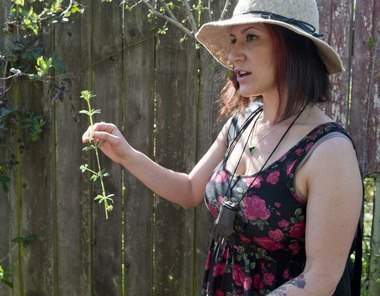Rebecca Lerner's Blog, page 7
May 25, 2013
Dandelion Hunter in the News
This morning you may have seen me on TV talking about the useful wild plants lunaria, yucca, California poppy, lemon balm, and sow thistle on the popular TV show “GardenTime,” which airs in Oregon, Washington, and Idaho, as well as on the web. You can watch the 4-minute segment above or on YouTube here.
I also recently appeared on Seattle’s KEXP “Mind Over Matters” radio show with host Diane Horn for a half hour interview, which you can listen to by clicking here and choosing May 18, and then “Mind Over Matters,” and then 7 am.
On Monday, I’ll be on the radio again on “London in the Afternoon” on Newstalk 1290 CJBK in London, Ontario, Canada, airing around 3 pm Eastern time.
And, I’m in print too! The national feminist magazine BUST has a review of my book Dandelion Hunter in their current issue, saying, “…By the end of the book, Lerner’s plant know-how is so advanced that she’s dosing her dog and her friends with herbal remedies and teaching budding foragers how to read a plant’s energy. Her earnestness combined with her musings about nature’s bounty occasionally beg to be turned into a Portlandia skit, but you have to appreciate her open-mindedness and her willingness to experiment.”
And there’s more news to come! Thanks for reading.







May 16, 2013
Wild Rose: A Delightful Snack
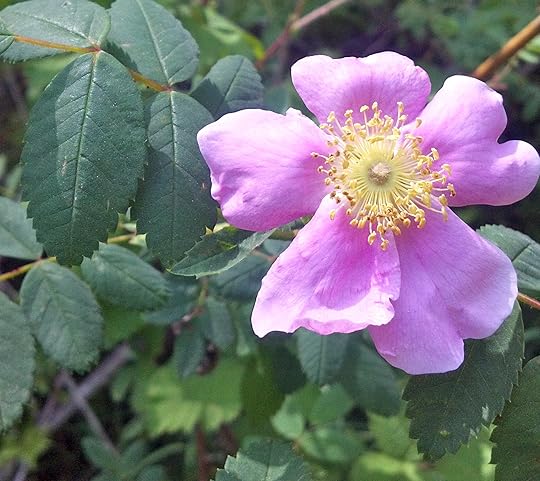
I’ve been enjoying the delightful flavor of fresh wild rose petals while exploring the wilderness areas around Portland lately, especially the sun-drenched places near the Sandy River Delta. Wild roses have far fewer petals than ornamental ones, but they do have some things in common: they’re pink, they smell the same, they have thorns, and their leaves are similar (compound leaves with many rounded leaflets, all with serrated edges). The variety pictured is most likely Rosa nutkana.
Flowers in the rose family have five petals and many stamens in the center. Ornamental roses got their additional petals through selective breeding that turned those numerous stamens into petals, according to botany author Thomas Elpel. Worldwide, there are 3,000 species in the rose family. They include such familiar fruits as blackberry, raspberry and strawberry.
In the fall, the rose plants — both native and ornamental — shed their flowers and develop seeds surrounded by flesh, which are fruits known as rose hips. Rose hips are also edible, and many people dry them for tea and enjoy the flavor as well as the extra Vitamin C. Rose hips can also be eaten raw, although it’s a lot more palatable to slice them open and remove the numerous seeds inside of them first. If you’ve got my book, “Dandelion Hunter,” then you’ve seen a recipe for turning them into a cranberry sauce substitute, which I highly recommend!

Wild rose
Rose petals are also medicinal, in that they are topically bacteriostatic, meaning they inhibit bacteria from multiplying. Out in the field, if you got a cut or a wound of some kind, rose petals could be used as a nice wilderness bandage to prevent infection.
Plants can heal us on many levels, not just the physical. When I approach this plant in a Reiki trance and tap into the plant-spirit perspective, I find that it is an extremely high-vibrational herb whose essence is unconditional love. It makes a lot of sense, then, that rose has this association in our culture with love, as well as romance, kindness, and the heart.
 Upcoming Classes in Portland:
Upcoming Classes in Portland:
* Urban Foraging 101 from 2 p.m. to 5 p.m. on Sunday, May 26, in the NE Alberta Arts district. $40. Details here.
* Stinging nettle plant-spirit meditation from 7 p.m. to 9 p.m. on Thursday June 6. $20 to $40 sliding scale. Details here.
* Intro to Herbal Medicine Making, a hands-on class that gets your apothecary started, from 2 p.m. to 5 p.m. on Sunday, June 23, at 1611 SE Bybee. $45 includes all materials and includes a tincture and salve to take home. Details here.
***
Learn many more wild plants of spring at my new Search Plants! page.







April 30, 2013
Media Love for ‘Dandelion Hunter’
Photo by Brent Wojahn/ The Oregonian
Publishers WeeklyDandelion Hunter: Foraging the Urban Wilderness
“This may be the funniest herbal adventure you’ll ever read.”
Booklist
Dandelion Hunter: Foraging the Urban Wilderness
“An uplifting tale of contemporary self-sufficiency.”
The Oregonian
Portland urban forager explores city’s edible weeds
“Lerner’s writing style is similar to her personality — frank, humorous, edgy, with an environmental bent.”
Oregon Public Broadcasting
Watch video: Urban Forager Rebecca Lerner Returns as the Dandelion Hunter
“She is part explorer, part advocate for natural medicine, part historian, part journalist and storyteller…Lerner gives an autobiographical account of her experience combing the streets of Portland, learning and sharing tips on how foraging fits into a modern lifestyle. She also talks a lot about transformation, a concept with which she has a good deal of personal experience.”
Willamette Week
Rebecca Lerner, Dandelion Hunter
“Like any Portlander, you’ve no doubt already planned your survival tactics for the impending zombie apocalypse—weapons, allies, a practical yet fashionable ensemble. But how long would canned goods sustain you? Eventually you’ll need to search for food…Dandelion Hunter will leave you looking at your yard differently.”
Eugene Register-Guard
Author forages for secrets of survival in a city
“There’s a lot to be said for — and in — “Dandelion Hunter,” including vignettes of like-minded friends and their own foraging experiences. It’s like that throughout, a foraging not only of food but also information about science, philosophy, nutrition, environment, medicine and friendship. Altogether, a filling read.”
Lavida Locavore
Book Recommendation: Dandelion Hunter
“By using her own experiences to construct a narrative, she teaches readers valuable lessons about foraging foods…an incredibly enjoyable introduction to foraging from a very human perspective.”
Punk Domestics
Dandelion Hunter: Review and Giveaway
“Through Lerner’s eyes Portland unfolds like a pop-up book of useful plants. What to the lay person’s eye might look like weeds emerging from a crack in the pavement or the impenetrable thicket of an overgrown yard becomes a virtual Garden of Eden. The plants leap out to her, speak to her. Indeed, by the end, they become nearly human. After reading this book, you may think of your next trip to the park as more of a family reunion.”
Wild Food Girl
Ode to the Dandelion Hunter
“I appreciate a good story as much as I do good information, and this book has both…I loved it.”
Catch me on tour next week in Washington state and you’ll hear on me on the radio at KUOW in Seattle and KAOS in Olympia!
***
Upcoming classes in Portland:
- Urban Foraging 101: 2 to 5 p.m. Sunday, May 26, $40, NE Alberta. Details here.
- Plant Spirit Workshop: Stinging Nettle. 7 to 9 p.m. Thursday, June 6, NE Alberta. $20 to $40 sliding scale. Details here.
- Intro to Herbal Medicine: 2 to 5 p.m. Sunday June 23, at HARP in Sellwood. $45. Details here.







April 22, 2013
On How Foraging Helps Wild Land
Image by Danmala
In honor of Earth Day, check out this interesting interview with NJ-based wilderness skills expert and author Tom Brown, Jr., and Larry Dean Olsen, a survival skills teacher out West, excerpted from an article on Hollowtop, a primitive skills website run by Thomas Elpel, the Botany in a Day author.
“Question: Primitive skills practitioners have sometimes been criticized by environmentalists and those who espouse “leave no trace” philosophy as despoilers rather than protectors of the Earth. Is there any validity to these accusations or concerns?
Tom: Let me answer that one first. I love this one. There’s the old survival philosophy which is, I think, the European way of thinking that the land is put here for our abuse and use, to do with as we wish. But I believe that a true survivalist is a caretaker of the Earth. Things must be harvested. Things must be adjusted and balanced. A survivalist put into a forest like this that is ailing, overgrown with trees killing each other off could actually be a positive effect, knowing what to take and when to take it. They are not just a caretaker, they’re a healer. We’re not a mistake from the Creator. We belong here and if we do this correctly as a survivalist, we are as important as the wolf is to the deer herd or the fox is to the rabbit population. And I know that Larry teaches that same thing, whenever you gather a plant, whenever you use a material, the Earth is put back as we found it but better. I believe that this attitude of “leave no trace” is like passing somebody wounded in the woods, saying hello and leaving. I look at the Earth as dying and it needs survivalists as healers. Instead of passing that person by, bandage the wounds. Fix what ails them and then go on.
Larry: I think if we lock up the Earth in the name of environmentalism, we’ve taken ourselves away from the Earth. And there’s no hope for us. I had a little story I wanted to illustrate that with. I’ve often said to people who have challenged me on that when they say: “What are you doing to the land out there when you take these groups of people out on the land?” And I say, “Well the entire group, probably does less damage than one cow does in the same amount of time.” Cattle, although they keep the grass down and keep things cleared out and everything, they can still be very destructive to water holes and that kind of thing, and we don’t do that.
The good illustration of that is when I was teaching at Brigham Young University I used to take my classes out to a place called West Mountain and there was a hillside out there that was just lush with biscuit root and sego lilies and fritillary bulbs. There were seven or eight different bulbs you could dig out there. And I would take a class of 30-40 people at a time, and sometimes three or four sections of those and have a hundred people out there, all with their digging sticks, digging on that hillside. I pretty well let them randomly go through but always with the caution that if you are digging a little patch here, always leave two or three. Don’t dig all of them, leave some of them. They were pretty respectful for that. Then I began to notice after the third year of doing this using this same area that every year they’d come up just as thick or thicker. And by the third year we began to notice that the bulbs were bigger and better. And after eight years of working that same ground every spring, we were getting that little thing they call the Indian potato that was usually about as big around as the joint in your little finger, they were now as big as onion bulbs.
Then an environmentalist group contacted me and wanted to send somebody over to interview me, and they challenged me on the destruction of wild plants in the environment. Well the sego lily is a state flower of Utah so they didn’t want us to dig any of those and I just had to say, well come with me. And I took them out there and showed them what had happened. Then I took them over to another place where that hadn’t been done and showed them how they were there. And in fact as stewards of that piece of ground, we had actually improved, not only the ground itself by loosening it up, but we’d improved the size of the bulbs, we had improved the habitat that was there in many ways. And I really believe that man is the steward of the Earth and that we have that veritable command from the Almighty to take care of it and to, what did he tell Adam and Eve, till it, you know? Make it fruitful and improve it and I think that’s just what we are doing. We tend it.”







How to Dry Medicinal Plants
 Drying plants might seem to be a simple subject, but it’s a frequently asked question by first-time wildcrafters at my classes. I thought it’d be helpful to write about here for everyone to have as a reference.
Drying plants might seem to be a simple subject, but it’s a frequently asked question by first-time wildcrafters at my classes. I thought it’d be helpful to write about here for everyone to have as a reference.
UV light and heat can break down plant matter and their medicinal components, so it is a good idea to dry your wild harvested plants in the shade. I got a neat shelving unit of metal screens from IKEA that I use to dry my plants in my office/apothecary. Another thing I do often is string a nylon cord like a clothesline across the room, and hang the fresh herbs in bunches upside down from it, using twisty ties to both bind them and secure them to the cord.
Once dried, I store the plants in glass mason jars and put them on a wooden shelving unit (also IKEA, as it happens) and cover that shelf with a tapestry so that it is protected from sunlight. I keep my jars of tinctures in Crown Royal bags (gifted by friendly tenders of bar) in a dark drawer (you can buy brown bottles, too, which also help keep the light out).
I wanted to get a better understanding of why we need to shade-dry herbs, so I asked my friend Nick Zemp to explain. Zemp is the director of the Grey Mountain Herbal Clinic in Provo, Utah; a certified clinical herbalist practicing both Chinese and Western approaches with 15 years experience; and a student pursuing a B.S. in biochemistry at the moment. So, really a good guy to ask! Zemp explained:
Zemp
“UV light is actually pretty hard on stuff. Once a plant is harvested it can no longer photosynthesize and produce energy or other important molecules like carotenoids that protect plants from harmful UV light. The best place to dry plants is in a cool, dry place. Many phytochemicals do degrade via heat and light, such as many vitamins and volatile compounds (things that evaporate easily) which are many times the substances that are ‘active’ in the plant from a healing standpoint.”
And there you have it. For more info on herbal medicine making, check out James Green’s book, “The Herbal Medicine Maker’s Handbook: A Home Manual,” and/or David Hoffman’s book, “Medical Herbalism: The Science Principles and Practices of Herbal Medicine.”
Follow Nick Zemp on Twitter @GreyMtnHerbs and please like his Facebook page!
***
Upcoming Events:
- The next hands-on Medicine Making 101 workshop has been scheduled for June 23. Details here.
- Yesterday’s Urban Foraging 101 class was awesome! Next one is May 26. Details here.
- Just added a Plant Spirit Workshop with stinging nettle for June 6! Details here.







April 14, 2013
Miner’s Lettuce is Incredibly Delicious
 For a long time I had mistakenly assumed that the common miner’s lettuce that grows in the city (Claytonia perfoliata) is bland tasting, similar to chickweed. I had this misimpression, I think, because of my experience eating another species of miner’s lettuce that grows in the woods (Siberian miner’s lettuce, Claytonia sibirica), which is a boring but solid candidate for salad. But this spring, a big and lush patch of the common miner’s lettuce, Claytonia perfoliata, sprouted outside a cafe I frequent, and I grabbed a handful to taste, and oh my god! Wow! Succulent, flavorful, rich — it might just be the best tasting wild green there is!
For a long time I had mistakenly assumed that the common miner’s lettuce that grows in the city (Claytonia perfoliata) is bland tasting, similar to chickweed. I had this misimpression, I think, because of my experience eating another species of miner’s lettuce that grows in the woods (Siberian miner’s lettuce, Claytonia sibirica), which is a boring but solid candidate for salad. But this spring, a big and lush patch of the common miner’s lettuce, Claytonia perfoliata, sprouted outside a cafe I frequent, and I grabbed a handful to taste, and oh my god! Wow! Succulent, flavorful, rich — it might just be the best tasting wild green there is!
I very rarely harvest greens that are near the road and within peeing range of dogs, but I am making an exception for miner’s lettuce because a) it is very seasonal and will disappear soon and b) it is hard to find in my neighborhood and c) it is truly that delicious. “Pee is sterile,” I tell myself, “it washes off.” To be extra safe, I tried wilting the greens tonight. I hadn’t done that with miner’s lettuce before, either, and — oh my god! Wow! It’s incredible! It’s like spinach minus the oxalic acid (what gives spinach its tartness).
Other tasty things to do with miner’s lettuce would be putting it on a sandwich, eating it raw as a salad green, mixing it into a green smoothie, or pretty much anything else you can think of that you could do with spinach.
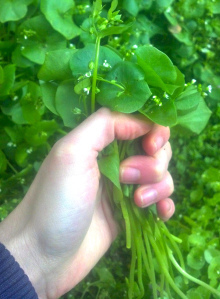 In terms of nutrition, miner’s lettuce has vitamin C and essential fatty acids. It grows under a foot tall even in robust patches, and seems to prefer street corners. I wish you good luck in finding a patch!
In terms of nutrition, miner’s lettuce has vitamin C and essential fatty acids. It grows under a foot tall even in robust patches, and seems to prefer street corners. I wish you good luck in finding a patch!
***
Upcoming events:
- Catch me reading from my new book, “Dandelion Hunter: Foraging the Urban Wilderness,” at Powell’s Books on Hawthorne in Portland this Thursday, April 18, at 7:30 pm.
- Learn to identify edible and medicinal wild plants with me as your teacher at the plant walk slash herbal smoking ceremony and meditation that is Urban Foraging 101, Earth Day edition, next Sunday, April 21, 2 p.m. to 5 p.m., meeting at the gravel lot outside Townshend’s Tea on Alberta Street in Portland. Everyone who comes gets a free mini field guide describing the uses of 30+ plants, and likely makes new friends, too. $40, no registration required. Details here.







April 4, 2013
Q&A: Can Fergus Eat Wild for a Year?
Photo from Fergus Drennan, originally in Plenty magazine
Fergus Drennan, the U.K. forager who recently wrote a fantastic guest post on this site about how to tap a birch tree, is a 41-year-old wild food educator and writer near Canterbury, Kent, England. He is gearing up to become a full-time, year-round forager. He plans to blog about his experience on his site, WildManWildFood, and possibly turn that into a book. I interviewed Fergus about his project.
Which wild foods do you anticipate will be your staples during the year-long wild food experiment?
Fergus: Acorns, chestnuts, walnuts, oysters, and various wild greens that are both abundant and can be utilized to extend their use beyond their usual growing season. Things like, nettles, wild garlic, and sea beet. Also collecting and bottling highly nutritious juices such as that of sea buckthorn berries will be very important. Of course, such ideas involve the anticipation of a good harvest. For a number of these foods 2012 was the worst I’ve known in 20 years. I hope that won’t be the case in 2013/4.
Will you be doing this experiment entirely solo?
Fergus: I’ll be the only person living entirely through the year eating 100% foraged food. However, for a week each month and on various weekends throughout the year, I’ll be inviting people to live, experience and document the adventure from their own unique perspective as they live the 100% wild diet with me. Such people may be foragers, chefs, bushcrafters, survivalists, a mother with children, permaculturalists or people with no knowledge of wild foods whatsoever.
What’s the longest you’ve gone solely or mostly eating wild food until now? How many hours do you think you’ll spend foraging or processing food per day?
Fergus: On two occasions I’ve gone 9 weeks eating solely foraged foods; 1 month was completely vegan. That was easier than I thought. I felt fantastic on many levels, although due to the climate in the UK it’s not really practical to be wild and vegan for more than a month or two. On both those occasions over 9 weeks, I found that I foraged on average for 2 hours a day, with about 4 hours given over to processing and cooking – and many hours researching.
Tell us a little bit about yourself.
Fergus: I’m very inspired by nature and female energies that are immense, powerful and challenging! Obviously I’m also inspired by all those who seek to live a good life in love, creativity, sensitivity and respectful engagement with the natural world and each other, be they poets, musicians, writers, politicians, friends, family. But I find that seemingly complete arseholes can be just as inspiring!
Do you consider yourself more of a foodie/chef type or a survivalist type or a naturalist forager, if you had to choose? Most foragers tend to be in one category or the others.
Fergus: My interest in foraging is very organic and evolving. To do it, explore it, research it and live it simply feels like an alignment with my purpose and deepest motivations and desires – an often tempestuous love affair with wild nature. On the other hand, I wonder if falling out of my pram as a baby simply activated some recessive hunter-gatherer gene!? Who knows why? It is a fundamentally beautiful, infuriating, animating and overwhelming mystery.
As to the type of forager I am, well, the honest truth is that I like to explore foraging and wild foods from as many perspectives as possible. I trained as a chef, have a degree in religious studies, have a profound interest in sustainability and primitive skills and…try to balance out my explorations in the foraging realm in all these ways equally.
What changes would you make to the modern world to make it more forager friendly?
Fergus: I live not far from a small city, there, and in many places around the world, urban (and elsewhere) trees are succumbing to disease. I’d love to see these all replaced by fruit and nut (chocolate) trees. Also, I’d make practical, fun and creative, permaculture-based environmental education a core subject of study from the earliest age, with serious study given to the works of naturalists, artists, poets, musicians, Osho, Charles Eisenstein, Mark Boyle, and David Deida in later years!
Tell us a bit about what you hope your project will reveal to the rest of us about being a full-time forager.
Fergus: I want to explore and share my explorations of the deep life affirming connection that working with plants and wild foods in particular can bring, fully embracing the challenges of the moment whilst also thinking in terms of the coming days and weeks, and in terms of how my activities impact now, in 5 years, 25 years, 250 years, 25000 years. Some will think me absurd, some brave, some inspirational, some deluded, some enlightened, some egotistical. No matter. This is what I feel I need to do. If it is the right thing it will happen and I will be supported. Support for this project is something I joyfully embrace, cherish and am immensely grateful for; resistance and criticism I see as an opportunity to inform what I do, and strengthen my resolve and push through.
“A society grows great when old men and women plant trees whose shade they know they shall never sit in” – Greek proverb
Fergus is looking for crowd-funding on IndieGogo to support him as he does this because a) he wants to get samples of the plants he eats tested for contamination and b) scouting, gathering, and processing enough wild food to live on is pretty much a full-time job.
To help Fergus fund his dream: http://www.indiegogo.com/projects/the-one-year-total-wild-food-experiment







April 1, 2013
Webcam Reading of Dandelion Hunter Today!
 Today, Tuesday, April 2, is the big day! I’ll be doing my internet book tour event at 7 p.m. Eastern / 4 p.m. Pacific on Shindig.com to read some excerpts from my new book Dandelion Hunter! I’m also looking forward to a Q&A segment, so bring your questions!
Today, Tuesday, April 2, is the big day! I’ll be doing my internet book tour event at 7 p.m. Eastern / 4 p.m. Pacific on Shindig.com to read some excerpts from my new book Dandelion Hunter! I’m also looking forward to a Q&A segment, so bring your questions!
The platform is free and very easy to use and works much like Skype — and if you’re shy you can even hide your camera and ask questions by typing, too.
To participate or watch the event, go to this link at 7 p.m. Eastern / 4 p.m. Pacific:
http://www.shindig.com/event/dandelion-hunter







March 23, 2013
Guest Post: How to Tap a Birch!
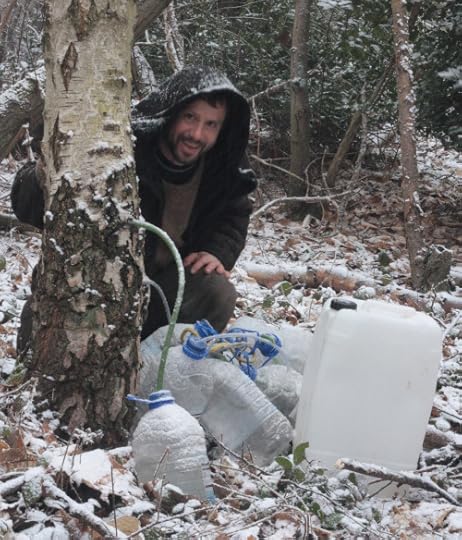 The following post is by “Wildman” Fergus Drennan, an expert forager in the U.K. who is preparing to embark on a year-long adventure of full-time foraging! Click here to learn more about that. (And stay tuned — I’ll be interviewing Fergus very soon on this site!)
The following post is by “Wildman” Fergus Drennan, an expert forager in the U.K. who is preparing to embark on a year-long adventure of full-time foraging! Click here to learn more about that. (And stay tuned — I’ll be interviewing Fergus very soon on this site!)
The Sap is Rising: Collecting birch sap for mineral water, wine, beer, vinegar and syrup
I’ve a confession: although my long-standing interest in wild food cookery does add incredibly wild and nutritious versatility to my daily menu with respect to rich soups, unique salad combinations and intriguing side vegetables – all very health promoting and worthy; truth be told, I’m actually somewhat of a sugar addict. Yet, for the most part, sweet wild foods are associated with the abundant fruitfulness of summer and autumn – apples, pears, cherries, blackberries, bilberries, mulberries etc, and as delicious as such fruits are in their unprocessed state or as fruit leathers, their sweetness is invariably counterbalanced by varying degrees of acidity. Hardcore, unadulterated and non-toxic sweetness is actually quite hard to come by in the natural world, at least where I live.
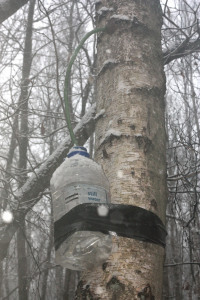 Yet, from as early as the final week of February (Southern England) until as late as the end of April (Scotland), and with a similar early to later coming of the spring across the different states of the US, that hardcore sweetness lies quite literally in untapped abundance, residing in diluted form within the trunks of some of our commonest trees: Birch (Betula species), Lime (Tilia species), Sycamore (Acer species), Walnut and various others. All, in theory, can be successfully tapped for their sap, the first two providing the best results in my experience. Birch, especially, is fail safe!. Indeed, on the basis of research and reports of success in this regard, I’ve tried to tap both walnut and sycamore for sap from February to April for the past 7 years, but without success. This year I intend to try our only UK native maple for the first time: The Field Maple (Acer campestre). For the purpose of this article then, ‘sap’ refers to birch sap only.
Yet, from as early as the final week of February (Southern England) until as late as the end of April (Scotland), and with a similar early to later coming of the spring across the different states of the US, that hardcore sweetness lies quite literally in untapped abundance, residing in diluted form within the trunks of some of our commonest trees: Birch (Betula species), Lime (Tilia species), Sycamore (Acer species), Walnut and various others. All, in theory, can be successfully tapped for their sap, the first two providing the best results in my experience. Birch, especially, is fail safe!. Indeed, on the basis of research and reports of success in this regard, I’ve tried to tap both walnut and sycamore for sap from February to April for the past 7 years, but without success. This year I intend to try our only UK native maple for the first time: The Field Maple (Acer campestre). For the purpose of this article then, ‘sap’ refers to birch sap only.
But why bother doing this? This is a question I’m frequently asked, quite often by people who have tried and have been disappointed that what drips from the tree tastes pretty much like water, not the sweet ambrosial nectar they had expected. Well, it’s a reasonable question I suppose. There are many answers. In the Ukraine and parts of Russia the sap is collected and sold as a type of mineral water, so they clearly value it. A fantastic, easy to make and reliable white wine can be made with a very distinct and pleasant taste, as well as beer, vinegar (see recipe at the end) and a rich caramel and molasses-like syrup. But, above all else, as with all foraging, it provides an excuse and opportunity to arrange your life according to the cycles of nature rather than the oppressive dictates of work routines and the terrible tick-tock tyranny of clock time or even traditional calendars. Each year I try to refine my understanding of when the sap flow begins and when it’s in full swing. This year it begun a day before the spring equinox, 5 days after reports that frogspawn was appearing in local ponds, and two days before the wood ants began to awake from winter slumber as they amassed to form new colonies. This is the realm of magic, awareness, and attunement, connecting with life, poetry and mystery and clocks serve no purpose!
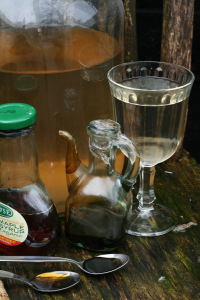 The sap then, which is actually about 95% + water, minerals and a little sugar, can be evapourated off to make a sublimely delicious if somewhat energy intensive syrup – it is the absolutely perfect accompaniment to elderflower fritters. In fact, the only near equivalent you can buy in this country is maple syrup. That is commercially viable because the ratio of sap required for a litre of syrup is 30:1, whereas for birch it is between 80 and 120:1 (I usually find that a 95:1 ratio is perfect). But don’t let that put you off. Once you’ve tasted birch sap syrup, the effort required to make it will seem more than worthwhile. For those who are unconvinced there are several other excellent uses for the sap once collected as I shall explain below, as well as various birch-related bushcraft skills to practice while the sap is simmering. First, though, how exactly is it obtained?
The sap then, which is actually about 95% + water, minerals and a little sugar, can be evapourated off to make a sublimely delicious if somewhat energy intensive syrup – it is the absolutely perfect accompaniment to elderflower fritters. In fact, the only near equivalent you can buy in this country is maple syrup. That is commercially viable because the ratio of sap required for a litre of syrup is 30:1, whereas for birch it is between 80 and 120:1 (I usually find that a 95:1 ratio is perfect). But don’t let that put you off. Once you’ve tasted birch sap syrup, the effort required to make it will seem more than worthwhile. For those who are unconvinced there are several other excellent uses for the sap once collected as I shall explain below, as well as various birch-related bushcraft skills to practice while the sap is simmering. First, though, how exactly is it obtained?







March 21, 2013
Urban Foraging Class Rescheduled

Image via Skidmore.edu
Friends, I have come down with a flu-like illness and unfortunately am not able to hold the Urban Foraging 101 class this Sunday.I am rescheduling it for next weekend, Sunday, March 31, same time/place, which is 2 p.m. to 5 p.m. and meets at NE 22nd and Alberta in the gravel lot outside Townshend’s Tea.
Sorry for those who won’t be able to make it due to observing the Easter holiday but I hope to see you at one of the future Urban Foraging 101 classes to look forward to this year, including the upcoming Sundays on April 21 and May 26.
Hope you’re all feeling better!
Some good news:
- The publisher released my book early so it is now available via Amazon and wherever books are sold!
- If you ordered a signed copy, I shipped your copy yesterday!
- If you haven’t got one yet, I’ll have some available at the class next Sunday!









